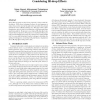Free Online Productivity Tools
i2Speak
i2Symbol
i2OCR
iTex2Img
iWeb2Print
iWeb2Shot
i2Type
iPdf2Split
iPdf2Merge
i2Bopomofo
i2Arabic
i2Style
i2Image
i2PDF
iLatex2Rtf
Sci2ools
ICCAD
2006
IEEE
2006
IEEE
A novel framework for faster-than-at-speed delay test considering IR-drop effects
Faster-than-at-speed test have been proposed to detect small delay defects. While these techniques increase the test frequency to reduce the positive slack of the path, they exacerbate the already well known issue of IR-drop during test. This may result in false identification of good chips to be faulty due to IR-drop rather than small delay defects. We present a case study of IR-drop effects due to faster-than-at-speed test. We propose a novel framework for pattern generation/application using any commercial no-timing ATPG tool, to screen small delay defects and a technique to determine the optimal test frequency considering both performance degradation due to IR-drop effects and positive slack.
| Added | 16 Mar 2010 |
| Updated | 16 Mar 2010 |
| Type | Conference |
| Year | 2006 |
| Where | ICCAD |
| Authors | Nisar Ahmed, Mohammad Tehranipoor, Vinay Jayaram |
Comments (0)

